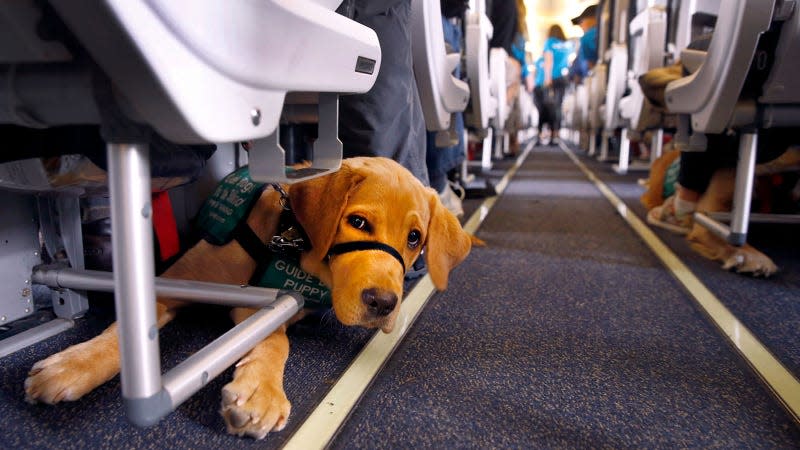Blind Travelers Kicked Off Flights Due To Confusing Service Animal Rules

Trained guide dogs are being turned away at airports. Photo: Paul Chinn/The San Francisco Chronicle (Getty Images)
Service animals are essential for many people with different needs who still need to navigate the outside world, including air travel. But a crack down on fake service animals boarding flights is hitting those who actually rely on the animals hard.
The Department of Transportation tried to clamp down on fake service animals and “emotional support” animals boarding flights with new regulations back in 2021, according to the Washington Post. The measure was meant to prevent people taking animals, such as peacocks or even miniature horses, needlessly on flights. But while the new rules did stop some people from, say, attempting to board a plane with a snake, they have made it much harder for people who actually rely on animals to get around. The Department of Transportation admitted to the Post that, for all its good intentions, it may have gotten this rule wrong:
Read more
Chess World's 'Anal Bead' Cheating Saga Quietly Comes To An End
Amy Coney Barrett Thinks People Have 'Misimpressions' of the Supreme Court
9 PC Games You Need To Play During Steam’s Latest Strategy Fest Sale
Retired Judge Pinpoints 'Stunningly Stupid' Moment Trump's Legal Team Lost a Hearing
While these rules might sound like a fair way to prevent fake service animals from boarding flights, they are unfortunately stopping many very real service animals from flying with their people. The Post spoke with visually impaired people like Elizabeth Schoen, who rely on guide dogs to safely navigate the obstacles that litter our everyday existence. According to Schoen, airline staffers told her she could not take her guide dog on a flight from Arlington, Virginia, to fly to Boston, Massachusetts, to tour graduate schools:
Schoen originally tried to submit her form online four days before her JetBlue flight, but it was rejected by the airline. JetBlue’s customer service advised her to bring the paperwork to the airport on the day of her flight.
When she arrived, airline staffers told her she had not submitted the form on time. Schoen tried to explain that JetBlue needed to make reasonable efforts to get her and Eva on the flight but was told that the airline had the right to turn her dog away.
“If you’re denying my dog, you’re denying me,” she said.
Schoen missed her flight and spent about $400 to fly the next day with a different airline. She was later reimbursed for her original flight and learned that the form had been rejected because she had used an incorrect flight confirmation code.
Some passengers have had their dogs rejected for simple paperwork mistakes while others found the forms difficult to fill out as they aren’t compatible with screen reader technology specifically designed to assist blind people. Then there’s the problem of different airlines enforcing the regulations unevenly, with some rejecting forms taken from other airlines’ websites.
Data from the Department of Transportation shows complaints from people with disabilities about the experience of taking their animals on flights has more than doubled, with 116 complaints filed in 2018 verses 451 filed in 2022.

 Yahoo Autos
Yahoo Autos 